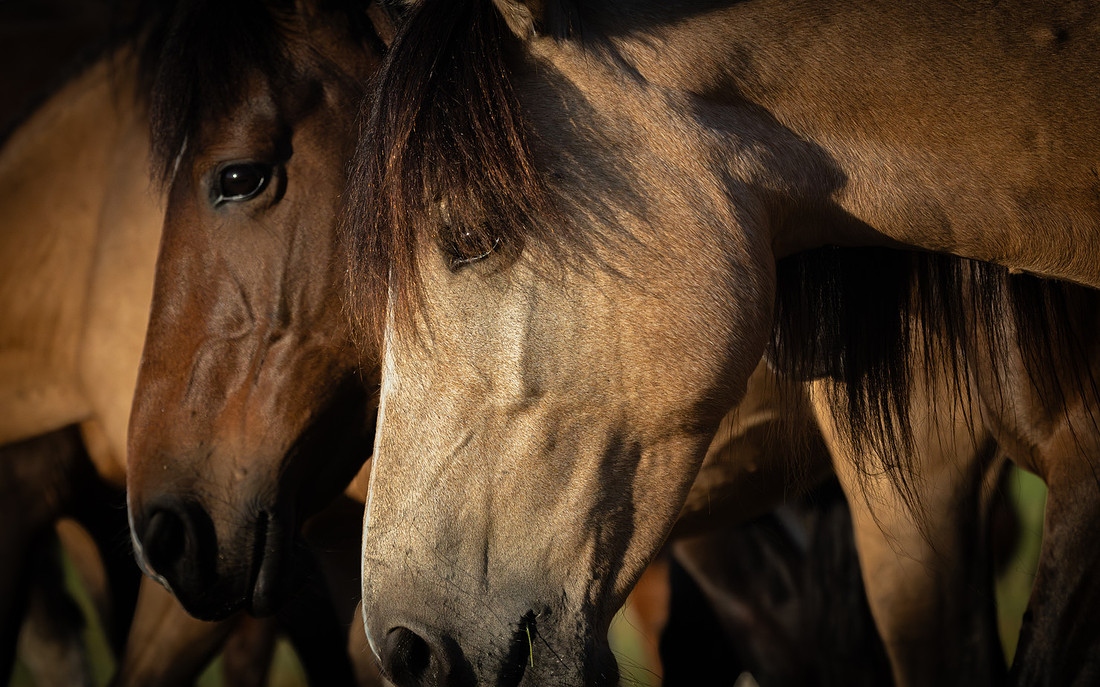Wild Still Exists: Capturing the beauty of horses
Wild Still Exists: Capturing the beauty of horses
Text and photos by Heather Cline


Stallions 'boxing' - attributed to dominance displays, territorial defense, mating competition, and social sparring
Photographing wild horses involves more than documenting a subject — it includes the landscape they call home and stories they convey. Whether you're navigating sagebrush flats or waiting for golden light, every frame comes with choices: how close to stand, when to click, and what to leave untouched. This guide offers tips for working ethically at a distance, leveraging natural light, reading subtle signs in the landscape, packing the right gear, and telling stories through post-processing. If you are interested in capturing images of wild horses, this article is a good starting point.
Shooting at Distance: Ethics and Techniques
- Use long lenses (300mm+) to avoid intrusion. Horses are prey animals and can become stressed by close presence.
- Stop-and-go approach: Walk a bit, observe, then pause for several minutes. Horses often acclimate to stationary observers quicker than moving ones.
- Anticipate movement: Learn body language cues like ear positions or tail flicks to predict sprints, grazes, or interactions.
- Don’t bait or herd: Never use food, sound, or motion to manipulate their position. Let their behavior unfold naturally.
- Stress signs = hands off: Flattened ears, wide eyes, fast regrouping — all cues to back off. A missed shot today means trust gained tomorrow.
A mare and her foal
Best Times for Natural Light
- Golden Hour: Emotion & Detail | Timeframe: ~1 hour after sunrise & ~1 hour before sunset
- Soft directional light enhances muscle tone, mane texture, and environmental dust or dew.
- Rim light around silhouettes creates dramatic visual tension — especially during movement.
- Horses tend to be more active early morning, offering dynamic shots like grazing, trotting, or social interactions.
- Overcast Midday: Soft Contrast | Timeframe: Late morning to early afternoon (when clouds diffuse sunlight)
- Even lighting avoids harsh shadows — ideal for intimate portraits or documenting behavior.
- Works well for storytelling compositions, like interactions or resting poses.
- Late Afternoon: Warm, Sweeping Landscapes | Timeframe: 2–3 hours before sunset
- Landscape integration shines here — you’ll get long shadows, golden terrain, and potential dust kicks from hooves.
- Great for shooting broader context: horses within sagebrush, mountains, or open valleys.
- Watch the weather: Dust storms, snowfall, and cloud breaks can create dynamic backdrops
Morning grazing
Tracking and Patience Strategies
- Look for signs: Fresh hoofprints, scat, grazed patches, or broken brush can indicate recent activity — especially near water sources like creeks or springs.
- Know your terrain: Horses tend to travel ridge lines or valley floors.
- Early morning & dusk: These windows often coincide with feeding and social activity.
- Wind direction: Stay downwind when possible, to minimize scent and sound.
- Use Optics First: Scan with binoculars before moving in.
- Blend in: Neutral clothing and a low profile help you fade into the environment, especially when perched on a ridge or behind brush.
A large herd is on the move
Gear for Remote Wildlife Photography
- Mirrorless advantages: Lighter and faster with fast autofocus, good ISO performance, and weather-sealing.
- Backup Body: For quick lens switches or emergencies — even an older DSLR can hold its own when needed.
- Telephoto (100 - 600 mm) for reach, portraits and tighter compositions - and Wide Angle (16–70 mm) for landscapes, and storytelling compositions.
- A Monopod is ideal for tracking shots or quick movement while a tripod is essential for early morning stills, twilight compositions, and slow shutter work.
- Protective Lens Covers: Neoprene sleeves keep dust, brush, and temp swings from damaging glass.
- Rain Gear: Poncho and rain sleeve for you and your gear if a sudden storm hits.
- Extra Batteries & Memory Cards: Cold mornings and long waits drain power fast. Double or triple up!
A high energy stallion
Post-Processing for Storytelling
- Whoa nellie! Show restraint in that saturation dial. Wild horses belong in rugged landscapes — keep colors natural to reflect their real-world environment.
- To preserve authenticity, leave scars, tangles, and windblown manes — these are visual records of their experience.
- Use highlights and contrast sliders to draw out that magical edge glow from sunrise or sunset.
- Use graduated filters to enhance backgrounds without affecting the horses.
- Play with temperature: A gentle warm shift can evoke golden hour emotion, while cooler tones suggest solitude or grit.
- Apply selective sharpening to eyes, manes, and hooves in motion — avoids harshness across the whole frame.
- Crop for storytelling: Sometimes a tighter frame on a foal’s expression or a band’s interaction tells more than a full landscape.
- Black & white conversion: Excellent for behavioral studies, emotional intimacy, and emphasizing contrast without distraction.


A more intimate look at these beautiful horses
Whether you're a seasoned wildlife photographer or novice, understanding wild horse photography is about more than camera settings — it’s about respect, observation, and intention. These tips are intended to go beyond technical insight and provide a deeper appreciation for photographing wildlife with purpose. To see additional wild horse images, visit my gallery here.



